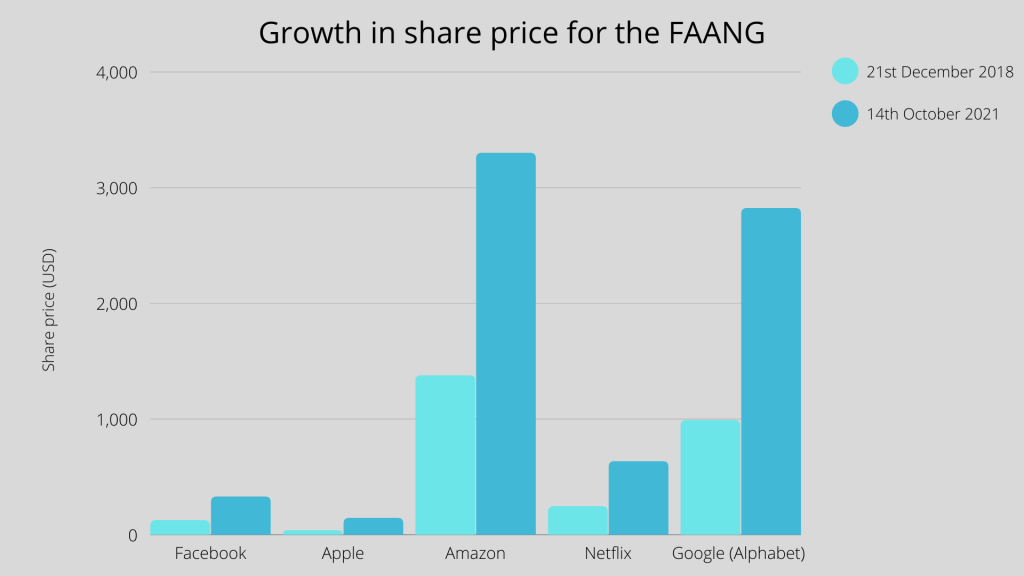
What is Techlash?
The term techlash has constantly been used over the last few years, referring to the “…growing animus toward large technology companies (a.k.a., “Big Tech”) and to a more generalized opposition to modern technology itself, particularly innovations driven by information technology.” (D. Atkinson et al., 2021). However, before such negative views became more mainstream, large technology companies such as Facebook, Apple, Amazon, Netflix and Google (FAANG) were seen in a positive light. For instance, back in 2010, Mark Zuckerberg, the Chief Executive Officer of Facebook was called the “person of the year” (Halliday & Weaver, 2010). However, as the online environment was faced with more issues, many people’s view of technology took a turn, which resulted in the word ‘techlash’ being runner-up for the word of the year in 2018’s Oxford Dictionary (D. Atkinson et al., 2021).
Concerns
Online platforms and technology companies have been under the radar for multiple reasons. Some of the concerns that have been raised include:
- the abuse of market power
- facilitation in fake news
- violation of consumer privacy
- lack of responsibility in regulation
More specifically, cases such as the 2016 US elections as well as the Cambridge Analytica scandal added fuel to the development of the techlash phenomenon.
The lack of moderation can easily be identified as the issue, moderation being the “screening, evaluation, categorization, approval or removal/hiding of online content according to relevant communications and publishing policies.” (Flew et al., 2019). However, this one step in the cycle of online content creation and distribution is not easy to achieve. Additionally, regulation after distribution is also key in ensuring that the online environment is fair and safe for users. In saying this, the process itself seems relatively straight-forward, but it is the arrangement of who to carry out these practices that is difficult to put in place.
Who is the regulator?
The current regulatory framework relies upon self-regulation by online platforms even though it is not the most efficient or effective. Due to the abundance of information and content, media platforms themselves have also transferred a part of their responsibility onto their users. One example of this is in the case of Logan Paul’s video that included a man who committed suicide in Japan. Logan Paul is a successful YouTuber who currently has over 23 million subscribers and brings in millions of views per video. In relation to the controversial video shot in Japan, it was posted on the 31st of December 2017 and was taken down on the 2nd of January 2018. Although the video was removed after 72 hours, within the first 24 hours alone, the video was viewed over 6 million times (ABC News, 2018). At the time, Logan Paul had over 15 million subscribers, who many of were young teenagers. This raises the question of how vulnerable his audience is and how this might have influenced them. The video was not well received, Logan Paul’s viewers reacted quickly with reporting and commenting on the video, which led Logan Paul to take the video down himself. The issue with this situation is that it was the audience who took action, and even after such reactions the platform YouTube did not contribute to the matter themselves. With this came the argument that YouTube is merely a platform that does not interfere with content creation, but this idea of whether social network platforms should be considered platforms or media companies is debated.
Additionally, with online content that gains a lot of attention, there is often the chance of people saving a copy of the content. In fact, although the video has been deleted off of Logan Paul’s channel, it is still available on YouTube and other platforms through other user accounts.
This leads onto the question of who should step in. Governments in certain parts of the world have made an effort in making the online environment a safer place. For example, in Europe, legislators in the European Union have placed a new law known as the General Data Protection Regulation, and it applies to all technology companies that obtain and handle the personal information of European Union citizens no matter where the company is based in. Through this, it can be seen how Governments can insert their authority to protect technology users. In this regard, governments partaking in the moderation and regulation is largely beneficial. However, there also lies the issue of time efficiency. In order for governments to release new laws, an extensive amount of time will need to be put in before changes can occur. It is possible that by the time the law has been made, the issue would have worsened or evolved. There is also a difficulty in applying traditional models of policy making as the online environment is much more complex than traditional models of media production and consumption. Considering this factor, it indicates how technology companies and governments should collaboratively work together in order to produce a more desired result. Governments will enforce policies that push technology companies to become more involved in the moderation and regulation process. The collaborative effort will improve trust with users and provide a more user friendly environment.
Although having two parties continuously working together would be an improvement, a third party might also be essential to minimize the amount of issues. According to Palmer (2018), as cited in A. Hemphill’s (2019), the third basic approach for regulation is self-regulatory organization. A self-regulatory organization (SRO) “would consist of the leading organizations in the industry coming together to define responsible innovation principles that all members of the SRO would agree to abide by.” (Palmer, as cited in A. Hemphill, 2019). This suggestion if put into action would be a powerful tool that would allow for “The SRO… [to] oversee and regulate compliance with those principles, levy fines, and refer any violations to a federal regulatory agency, such as the Federal Trade Commission.” (Palmer, as cited in A. Hemphill, 2019), allowing for change across numerous platforms at one time. Still, this method requires a great amount of time and capital that technology companies may see as unproductive. This would be problematic as this method cannot proceed if technology companies refuse to partake in it, and even if technology companies saw this as valuable, coming to a unanimous decision will also require more time for change to occur, and risks tension between entities due to the possibility of disagreement.
The Market
Despite the techlash phenomenon, technology companies have increased in market power over the years. According to Financial Times (2018), FAANG “… in 2018…led the collapse of the markets.”. This can be seen through the companies share prices that on the 21st of December 2018 all saw a significant dip. Since, however, FAANG have not only recovered but have grown exponentially (as can be seen below).

In numerical form:
- Facebook: 21st December 2018 – $124.95 USD, 14th October 2021 – $328.53 USD
- Apple: 21st December 2018 – $37.68 USD, 14th October 2021 – $143.76 USD
- Amazon: 21st December 2018 – $1377.45 USD, 14th October 2021 – $3299.86 USD
- Netflix: 21st December 2018 – $246.39 USD, 14th October 2021 – $633.80 USD
- Google (aka. Alphabet): 21st December 2018 – $991.25 USD, 14th October 2021 – $2823.02 USD
In terms of how many social network users there are world wide, technology companies have also consistently grown (Statista, 2021).
- 2017: 86 billion
- 2018: 3.14 billion
- 2019: 3.4 billion
- 2020: 3.6 billion
It has also been forecasted that by the year 2025 there will be 4.41 billion social network users worldwide (Statista, 2021).
Conclusion
Whether the techlash phenomenon will catch more mainstream attention or not, technology companies will still continue to thrive as they have become irreplaceable and essential for everyday life. However, that should not interfere with the effort to make the online environment more transparent, fair and safe for all users.
References
- Hemphill, T. (2019). ‘Techlash’, responsible innovation, and the self-regulatory organization. Journal Of Responsible Innovation, 6(2), 240-247. https://doi.org/10.1080/23299460.2019.1602817
- ABC News. (2018). YouTube star under fire for video of apparent suicide victim[Video]. Retrieved 13 October 2021, from https://www.youtube.com/watch?v=WjNFGZLJLss.
- CBC News: The National. (2018). Regulating social media: Governments considering options [Video]. Retrieved 14 October 2021, from https://www.youtube.com/watch?v=OriGCq7UgXs.
- Atkinson, R., Brake, D., Castro, D., Cunliff, C., Kennedy, J., & Laughlin, M. et al. (2021). A Policymaker’s Guide to the “Techlash”—What It Is and Why It’s a Threat to Growth and Progress. Itif.org. Retrieved 12 October 2021, from https://itif.org/publications/2019/10/28/policymakers-guide-techlash.
- Financial Times. (2018). Techlash: the fall of the Faangs[Video]. Retrieved 12 October 2021, from https://www.youtube.com/watch?v=QddDZfaDeEQ.
- Flew, T. (2021). ARIN2610 Week 3 240821: Week 3 – Internet Interests, Politics and Economics. Lecture.
- Flew, T., Martin, F., & Suzor, N. (2019). Internet regulation as media policy: Rethinking the question of digital communication platform governance. Journal Of Digital Media & Policy, 10(1), 33-50. https://doi.org/10.1386/jdmp.10.1.33_1
- Google Finance (2021). Retrieved 15 October 2021, from https://www.google.com/finance/.
- Halliday, J., & Weaver, M. (2010). Facebook’s Mark Zuckerberg named Time magazine’s person of the year. The Guardian. Retrieved 13 October 2021, from https://www.theguardian.com/technology/2010/dec/15/mark-zuckerberg-time-person-of-the-year.
- Number of social media users 2025 | Statista. Statista. (2021). Retrieved 12 October 2021, from https://www.statista.com/statistics/278414/number-of-worldwide-social-network-users/.
Tracy Chenh – Group 5

This work is licensed under a Creative Commons Attribution-NonCommercial 4.0 International License.